For years, scientists have been closely monitoring a puzzling and expansive anomaly in Earth’s magnetic field known as the South Atlantic Anomaly (SAA). Spanning from South America to southwestern Africa, this vast area is characterized by a significant decrease in magnetic intensity, presenting a curious natural occurrence that has garnered the attention of researchers around the globe, particularly NASA. While the implications of this anomaly may not pose a direct threat to life on Earth, its effects on satellites and spacecraft operating in low-Earth orbits have raised substantial concern.
The anomaly, often described by NASA as akin to a “dent” in our planet’s magnetic shield, appears especially troublesome for technological instruments in orbit, such as those on the International Space Station (ISS). As these spacecraft traverse the region, they are exposed to a weakened magnetic field that allows charged solar particles to penetrate more deeply than usual, potentially leading to malfunction or damage. This vulnerability has compelled mission operators to implement precautionary measures—frequently shutting down sensitive systems to safeguard against the high-energy protons that can wreak havoc on satellite electronics.
At the core of this intriguing phenomenon lies the constantly shifting dynamics of Earth’s magnetic field, generated by the movement of molten iron within the outer core. The intensity of Earth’s magnetic field is not uniform, impacted by various geological structures beneath the surface. Research indicates that the African Large Low Shear Velocity Province—a substantial formation located nearly 1,800 miles below the African continent—may significantly disrupt how the field is generated, contributing to the anomaly’s weakened state.
NASA geophysicist Terry Sabaka has highlighted that the SAA exemplifies a decline in the influence of the dipole magnetic field in this region. More specifically, a localized magnetic feature that possesses reversed polarity seems to be strengthening, causing the magnetic intensity to diminish significantly when compared to surrounding areas. This understanding of the SAA could herald a new appreciation of how geological structures interact with magnetic fields and the implications they carry for space exploration.
Significant advancements in our comprehension of the SAA have emerged from various scientific investigations. One notable study, led by NASA heliophysicist Ashley Greeley, revealed that the anomaly is not static; it drifts over time. This observation was validated through meticulous tracking via CubeSats, confirming that the phenomenon is dynamic in nature and subject to change.
Even more astonishingly, the SAA appears to be in the process of splitting into two distinct regions, each with a unique center of low magnetic intensity. This bifurcation raises profound questions about the future of the anomaly, as scientists hypothesize what implications this change may have for both Earth and space-based technology.
Initial research suggests that the SAA is not merely a transient anomaly. Evidence uncovered by geophysicists indicates the phenomenon may have existed in various forms over the past 11 million years. This long-term perspective on the SAA challenges assumptions regarding magnetic events and their potential impacts on Earth. While changes in the magnetic field can lead to periods of disruption—such as geomagnetic reversals—these occurrences are infrequent, often occurring over vast timescales.
The implications of the South Atlantic Anomaly extend beyond immediate technological concerns. This geological and magnetic curiosity serves as a compelling opportunity for further scientific exploration and understanding of Earth’s internal dynamics. As researchers continue to monitor ongoing changes to the SAA, the findings may illuminate broader theories regarding magnetic fields and their behavior through geological time.
While challenges remain in completely decrypting the complexities of the SAA, NASA and other scientific institutions are committed to thorough observation and analysis. The anomaly acts not only as a source of potential risk for satellite technology but also as a critical topic for astrophysical inquiry.
As NASA’s Terry Sabaka notes, despite the gradual nature of the SAA’s movements, continuous observation remains paramount. The future may reveal even more about this magnetic puzzle, ensuring that our understanding of Earth’s magnetic field—and the changes it undergoes—continues to evolve. The SAA reminds us of the intricate connections between Earth’s geophysical phenomena and the technological frameworks we rely upon.

